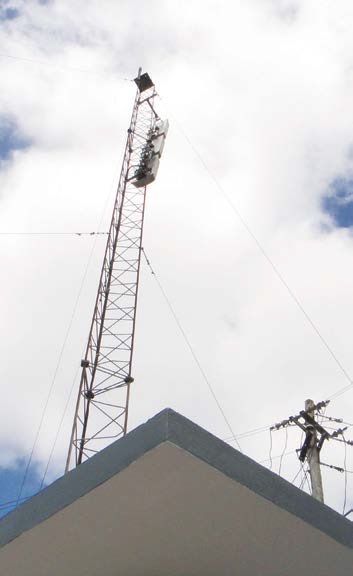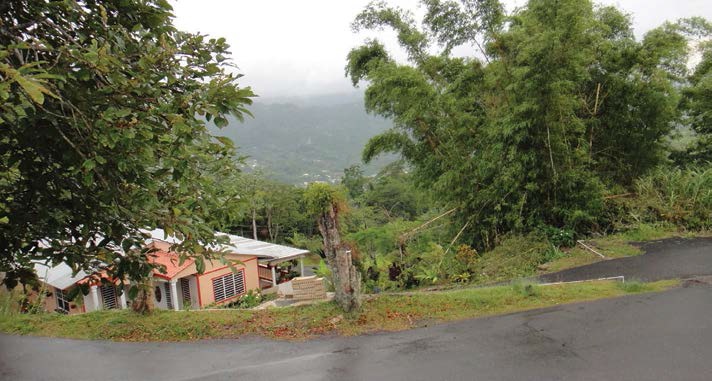Getting Ready for the Repack
HAWAIIAN ISLANDS—After the FCC incentive auction is complete, likely before we transition to ATSC 3.0, many UHF TV stations will have to move to new channels. Many TV translator stations will have to find new channels, if they can.
Once the new channel table is published, stations will have three months to file applications for their new channel and have three years or less to move to their new channel. The exact timetable will depend on how the FCC structures the channel moves. Some markets may have to transition earlier and it is possible the timeline could be on a station-by-station basis depending on the impact a station has on other stations.

W28EH tower and antenna at the translator site in Adjuntas, Puerto Rico
The FCC’s auction procedures public notice notes that one of the priorities in the repacking will be to avoid channel changes. However, it is reasonable to expect that if the FCC is able to take 84 MHz from broadcasters, every station transmitting above Channel 37 will have to change channels unless the FCC sticks them in the 600 MHz wireless band. It also seems inevitable that some stations below Channel 37 will have to change channels, to make room for those moving down from above 37.
What can stations do to prepare for the change? The FCC’s auction rules unfortunately have no provision for reimbursing stations that have to change channels for expenses incurred before they are assigned a new channel. However, there are reasons why it might be worth spending some money now to avoid pain in the future.
TIME FOR A NEW TRANSMITTER?
Many stations are using transmitters installed 15 years ago at the start of the DTV transition or are using older analog transmitters converted to DTV at the end of the DTV transition. Old IOT UHF transmitters are inefficient and maintenance is becoming increasingly difficult and expensive. It might make sense to spring for a new, high-efficiency, solid-state transmitter now, perhaps with some incentives from the local utility, and avoid the pain of keeping the old transmitter running for another three years. While details on exactly how channel change reimbursements will be handled haven’t been released, the FCC may not cover the total cost of a new transmitter if all that’s needed to change the old transmitter’s channel is a new exciter, some driver amplifiers and mask filter. Any incremental cost will likely have to be paid by the station.
With the huge increase in demand for transmitters and installation talent during the repacking period, waiting to replace a transmitter near end-of-life could end up costing more, even with the reimbursement, than replacing it now.
The professional video industry's #1 source for news, trends and product and tech information. Sign up below.
Many high-power UHF stations use slot antennas, which will have to be replaced if the channel changes. Replacing antennas during the limited period allowed for the repacking will be difficult. Weather limits the seasons when tower work can be done in many parts of the country—snow and ice in the northern states, hurricanes and tornados in the southern states. Work will have to be coordinated with other stations (TV or radio) on the tower. Aside from creating an inventory, having a structural analysis of the tower and planning the steps required for antenna replacement, not much can be done until the final channel is known. With a few exceptions, the antenna pattern on the new channel will have to match that from the old channel.
The FCC will allow stations predicted to receive more than 1 percent new interference to modify their facility, even using a different channel, if this can be done without causing interference to other stations or wireless operations.
One way stations that need to replace an old antenna—perhaps to add vertical polarization or resolve problems with the original antenna—can avoid going through the process again during the repack is to use a broadband panel antenna. While broadband antennas are more expensive than single-channel antennas and put greater load on the tower, multiple stations can share the same antenna, reducing the total number of antennas on the tower, and splitting the cost among multiple stations.
Stations with nondirectional antenna patterns should have no problem switching to a broadband panel antenna, but problems arise if a directional pattern is required and it has to precisely match the pattern of the old antenna. Panel antennas have more ripple in the azimuth pattern (peaks and nulls). The maximum effective radiated power (ERP) of stations with directional antennas will be limited by the ERP in the broadband antenna peaks. This will result in a reduction in ERP in the nulls and a reduction in coverage.

The W28EH tower and antenna serves the town of Adjuntas, Puerto Rico.
There are ways to provide different patterns with one broadband antenna—Merrill Weiss did it with his design of an RFS panel antenna on Mount Wilson several years ago, but it isn’t easy and there is a practical limit to the number of patterns one antenna can support.
Considering that antenna changes are likely to be a major stumbling block in the repacking, it would make sense for the FCC to allow more variation in antenna patterns and transmitter locations in a market. With a more flexible approach than is currently proposed, the broadcasters left after the auction, working as a group in adjacent markets, would be able to agree on facilities that are easier to build, reduce interference and ensure coverage in their primary market.
This will require more than 90 days for filing applications. However, extending that period to 180 days, or perhaps longer, could shorten the time required for repacking, particularly in congested markets like the northeast United States, by allowing more use of nondirectional antenna patterns and more sharing of antennas and transmitter sites.
It could also reduce the cost of repacking by making it attractive for antenna companies to build shared broadband antenna sites for temporary use during the repack and permanent use, as a main or backup site, after the repack.
TRANSLATORS AND DOCRS
Translators are often required to provide over-the-air TV in rural areas, but finding channels for them may be difficult after the auction. One approach I’ve found that works well in terrain-isolated areas is the use of echo-canceling digital on-channel repeaters (DOCR).
In one system I’m working on, interference between two DOCRs and the main station is predicted to be minimal, even without considering that in many cases the interference will fall within the ability of the DTV receiver’s equalizer to remove it as multipath. I’ll have more on DOCRs in a future column.
Translators from GatesAir and Anywave Communications offer an option allowing them to be used as echo-canceling onchannel “translators.” While DOCRs cost a bit more than a conventional translator and require careful planning, making the change now will help ensure that viewers depending on translators will not lose service after the auction.
I’ve developed some Python programs to allow analysis of co-channel interference and coverage then given an array of field strengths created by another propagation analysis program. I’m using SPLAT.
If you want more information on them, email me atdlung@transmitter.com.
For more information on the Spectrum Incentive Auction, join TV Technology, B&C and auction experts discussing what must be anticipated in the months to come regarding planning for, and participating in, the auction, in a live Webinar on Thursday, Nov. 5 at 2:30 p.m. ET. Please register at https://nbmedia.wufoo.com/forms/spectrum-auction-preparation-pp86mny0bbremz/.

Doug Lung is one of America's foremost authorities on broadcast RF technology. As vice president of Broadcast Technology for NBCUniversal Local, H. Douglas Lung leads NBC and Telemundo-owned stations’ RF and transmission affairs, including microwave, radars, satellite uplinks, and FCC technical filings. Beginning his career in 1976 at KSCI in Los Angeles, Lung has nearly 50 years of experience in broadcast television engineering. Beginning in 1985, he led the engineering department for what was to become the Telemundo network and station group, assisting in the design, construction and installation of the company’s broadcast and cable facilities. Other projects include work on the launch of Hawaii’s first UHF TV station, the rollout and testing of the ATSC mobile-handheld standard, and software development related to the incentive auction TV spectrum repack. A longtime columnist for TV Technology, Doug is also a regular contributor to IEEE Broadcast Technology. He is the recipient of the 2023 NAB Television Engineering Award. He also received a Tech Leadership Award from TV Tech publisher Future plc in 2021 and is a member of the IEEE Broadcast Technology Society and the Society of Broadcast Engineers.
